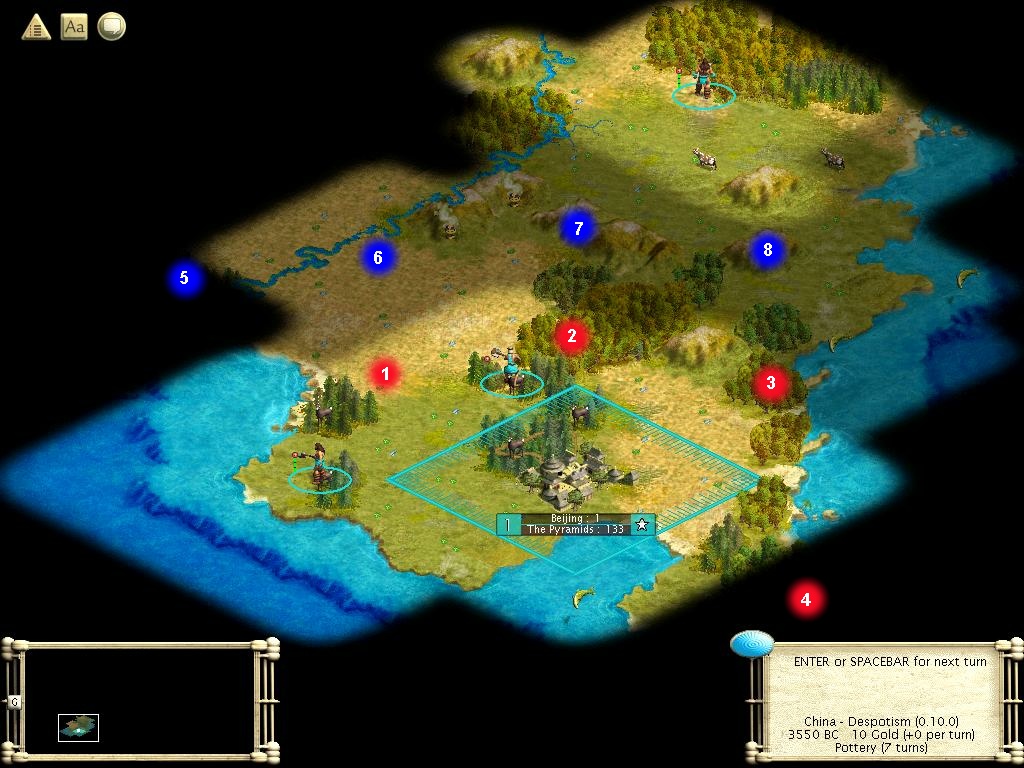Looks good Berrern! Did you use Dianthus' utility for this?
We will
definitely be following RCP for this game (its one of the key 'learning objectives' if you like). Does anyone not know what Ring City Placement (RCP) is, or what its done for? For posterity, I'll probably write a summary in a day or so.
A note about popping huts: Sometimes it can be a strategic decision as to whether you should pop a hut or not, because the contents of the hut are affected by your current game status: Military units, the number of cities you have, the difficulty level etc.
Check out
This post
smackster said:
Somebody posted this on Apolyton and claimed it came from Firaxis.
On Goody Hut Discoveries
Here are the conditions:
Gold
--The tile must not have any type of resource or luxury on it
Maps
--Always available
Nothing
--Always available
Settler:
--Player must not have a settler (active or in production) or any unit with the Settle AI stategy.
--Player must have less cities than (TotalCities/NumActivePlayers).
Mercenaries (skilled warrior):
--There must be a unit availlable to the Barbarians as well as the player and that unit must be able to be built (or have been built) by some player in the game
Tech:
--Player must still be in Ancient Times
Barbarians:
--Player must not have Expansionist trait
--There must not be a city within a 1-tile radius
--Player must have at least 1 city
--Player must have at least 1 military unit
Whilst I don't know of anything specific on the probabilities of what you get out of goody huts, it is known that on lower difficulty levels you are more likely to get techs and less likely to get barbs.
There is some empirical evidence of the probabilities (unfortunately I lost the link for this one

)
On Chieften you will get barbarians 5% of the time
On Warlord you will get barbarians 15% of the time
On Regent you will get barbarians 25% of the time
On Monarch you will get barbarians 35% of the time
On Emperor you will get barbarians 45% of the time
And we know that on Diety barbarians occur 55% of the time
On emperor, because everyone starts with the same number of settlers, we would not get a city out of the first hut, and we had a 45% chance (approx.) of getting barbs.

Other stuff:
I also liked your analysis of the worker irrigation options. That's exactly the sort of analysis that turns people into very good players!

What we need to do is decide what we're going to do about producing settlers etc.
We are currently getting 3 shields / turn. We've accumulated 3 shields towards the pyramids, with pottery in 7 turns. Next turn we grow to size 2, and then we'll be producing 5 shields / turn. Therefore, by the time we have pottery, we'll have around 38 shields. Note that pottery might take an extra few turns, because when we grow next turn, the citizen will be unhappy, so we'll have to manage that with luxuries. We will have an extra GPT, so it might balance out though.

I actually start a spreadsheet at work with more in-depth analysis, but left it there.

What I was trying to do was look at options around expanding as quickly as possible.
As I see it, we can either set Beijing up as a settler factory (of some description), or try to set one up elsewhere. In regards to the cows, they are quite a way away. They would need a bonus grassland for a good settler factory, which means a temple first. But how can we speed-up a settler factory in Beijing? Well, if the problem is getting water quickly enough, then to speed-up the process, why not build another worker? We can have one in 2 turns, and that will (roughly) halve the time to get the irrigation back.

In the interim, we can build some warriors for crowd-control, and pre-build a granary 'just-in-time'.

I'll look at my spreadsheet in more detail tomorrow....




 )
)
 There's no right and wrong way to do some of these things
There's no right and wrong way to do some of these things 
 And backing them up with the odd swordsman is effective too.
And backing them up with the odd swordsman is effective too.  Distance corruption is calculated based on the distance to the FP or Palace, whichever is closer. Rank corruption is a bit different, but unless the palace is miles from the rest of theempire, it doesn't matter. You can set up rings around the FP, then jump the palace away!
Distance corruption is calculated based on the distance to the FP or Palace, whichever is closer. Rank corruption is a bit different, but unless the palace is miles from the rest of theempire, it doesn't matter. You can set up rings around the FP, then jump the palace away!